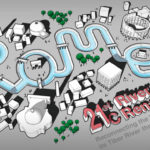The Architecture Competitions Yearbook emerges as an indispensable compass guiding architects, designers, and students through the labyrinth of architectural design competitions. It doesn’t merely showcase projects; it unveils narratives of triumph, revealing the secrets behind the success of each design. As you delve into its pages, you embark on a journey of discovery, unlocking the mysteries of what distinguishes a winning project from the rest.
The practice of architecture nurtures a unique interplay between aesthetic grandeur and functional genius. In the “Architecture Competitions Yearbook,” a publication of remarkable scope and depth emerges, offering an overview of this dynamic field through the lens of its most talented practitioners. This book does not merely gather an assortment of architectural blueprints and panels; instead, it weaves a tapestry of stories, parti diagrams, renders, thought processes, ambitions, and, ultimately, the realized dreams of its contributors. Within its pages, architects, designers, and students will find a compass that not only guides but also inspires, really pushing the boundaries of what is achievable in the world of architecture competitions.
One of the Yearbook’s most beneficial chapters is its unwavering dedication to demystifying the competitive edge. The book does an incredible job at transcending the role of a passive gallery and assumes the mantle of an educational aide. It reaches into the collective intellect of its featured architects, offering an exclusive view of their conceptual and executional processes. The section “How We Won That Competition” stands out as a pinnacle of this informative journey. Here, the curtain is pulled back, displaying the variety of ideas along with various methodologies that thess designers used respectively. From the finely tuned methods of architects Plata and Stankiewicz to the forward-thinking solutions of architect Krisiantara, their interviews (along with many others) are loaded with practical wisdom and creative ideas, inspiring others intending to leave their mark on the world of architecture.
Engaging in architectural competitions holds a transformative potential for architects, students, and designers at all stages of their careers. These contests offer a unique platform for experimentation, allowing creatives to test the limits of innovation and functionality without the constraints typical of client-driven projects. They offer a glimpse into the future of architectural design. Competitions catalyze professional growth by compelling participants to articulate a clear vision, refine their presentation skills, and engage with current trends and societal needs. Furthermore, the visibility gained from competing, especially when recognized or awarded, can be instrumental in propelling an architect’s reputation and attracting new opportunities. These competitions, with its inherent challenges and rewards, truly fosters a culture of excellence.
The “Architecture Competitions Yearbook” emerges as an invaluable resource in this context, elevating its relevance far beyond competing publications. As a compendium of impressive designs and their stories behind them, it offers a lens through which upcoming architects, students, and designers can envision their potential pathways to success. This book becomes a mentor, guiding other entrants through the intricacies of competition entry, from conceptualization to the final presentation. For the seasoned professional, it serves as a reservoir of fresh ideas and new approaches, an inspirational tool that keeps the creative juices flowing and encourages a reevaluation of established practices. Famous architects like Zaha Hadid and Frank Gehry catapulted to international recognition through their groundbreaking competition entries, demonstrating the pivotal role that architectural competitions play in shaping the careers of visionaries and innovators in the field. The Yearbook’s pages underscore the importance of resilience and creative risk-taking, qualities that define not only competition winners but also those who lead the evolution of architectural design. In a discipline that thrives on innovation and the constant push against boundaries, the Yearbook stands as a testament to what is possible when talent, ambition, and strategic thinking converge.
Undeniably, the Yearbook is assembled with the sort of pedagogical intent that benefits a wide audience. Inexperienced designers will find fuel for their developing skills, while veterans can indulge in a sprawling menu of new perspectives and techniques. It champions stories of success, but not without acknowledging the resistance these visionaries faced along their journey. Through this honest portrayal, a candid reflection of the architectural path unfolds, highlighting both the monumental achievements and the resilience required to attain them.
Aesthetically, its pages are saturated with ingenious concepts and experimental propositions, as the book showcases the finalists for each competition. Plus the Yearbook highlights a wide variety of competitions, all with incredibly unique prompts, further igniting the reader’s creativity. Every turn of the page is akin to stepping into a different world—a space where structures resonate with ambition and creativity and where the essence of architecture as a form of art shines.
As I immersed myself in the Yearbook, I found myself particularly captivated by the array of parti diagrams from various competitions and teams. Exquisitely presented within its pages, these diagrams served as a silent yet compelling narrative of the thought process behind the design evolution. The simplicity and elegance of these schematics drew me in, capturing the essence of concepts and helping me understand the underlying ideas. I found that since graduating and working in a more rigid job, looking at these diagrams in the Yearbook really sparks my creativity and keeps the ball rolling. I found them to be powerful storytellers, illustrating vividly the architectural reasoning that propelled each design from inception to fruition. Each parti diagram, in its simplicity, conveyed a tale of conception, evolution, and culmination—providing a unique view of the architectural design process that I personally find deeply fascinating and incredibly enlightening.
The realm of representation in architectural design is incredibly dynamic, with rendering styles continuously evolving alongside advances in technology and shifts in aesthetic sensibilities. The Yearbook’s compilations prove to be an invaluable asset in this context. It is akin to a looking glass into the heartbeat of the industry’s representational trends, offering glimpses into what the future might embrace. Seeing a diverse array of visual discourse—from hyperreal visualizations to more abstract, artistic expressions—this book never fails to inspire and stimulate fresh thinking. This ever-changing landscape of representation not only widens my perspective as a professional but also challenges me, as a reader, to continually refine and diversify my own representational toolkit. Each rendering, each drawing, each diagram becomes a nudge encouraging me to experiment, adapt, and ultimately, craft a visual language that resonates with my personal creative philosophy, and stands proudly in the spectrum of architectural representation.
However, the book’s true essence is encapsulated in the community it cultivates. It unites readers from disparate geographic and professional backgrounds with a mutual thread—their reverence for architectural inquiry and their insatiable thirst for growth. It champions the collaborative spirit and stands as a celebration of our collective intellectual wealth. Each competition entry featured within its pages reflects a collective journey toward excellence, highlighting the importance of unity and collaborative learning in fostering vibrant and resilient architectural innovation.
In summary, the “Architecture Competitions Yearbook” offers a comprehensive view of modern architecture, providing guidance for a forward-looking approach. Its emphasis on clarity, ongoing learning, and innovation encourages architects to challenge conventions and explore new possibilities in design. It celebrates past achievements, inspires future endeavors, and recognizes the significant influence of architecture on society. Whether you’re in search of inspiration, guidance, or a reflection of architectural pioneers, this book is a valuable addition to any library.
And to also note, the “Architecture Competitions Yearbook” releases a new edition annually, making it not only a valuable resource but also somewhat of a collector’s item. With each new edition, readers have the opportunity to stay updated on the latest trends, emerging talents, and groundbreaking designs in the architectural world. Building a collection of these Yearbooks over the years becomes more than just an accumulation of knowledge—it transforms into a curated archive, chronicling the evolution of architectural thought and practice over time. As each edition adds to the narrative of architectural innovation, it becomes a cherished keepsake for enthusiasts and professionals alike, offering a glimpse into the ever-changing landscape of architectural design.
In this crucible of competition and creativity, the “Architecture Competitions Yearbook” stakes itsclaim as a wellspring of innovation and an essential font of inspiration. It is more than a compilation of aesthetics; it is a compendium of ideas, an atlas of achievement illuminating the path to architectural eminence. Returning to the book each time offers a journey steeped in inspiration, brimming with the courage and clarity needed to continue shaping the canvas of our built environment. Truly, for anyone engaged in the act of making places that matter, this Yearbook is not just an asset; it is a quintessential guide.












